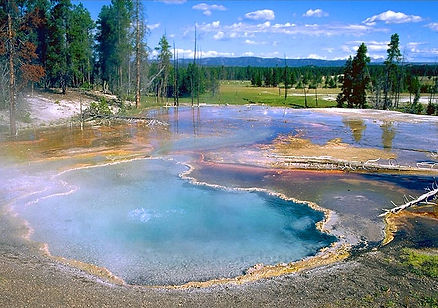Extreme Living
Acidophile


Identification:
-
Scientific Name: Ferroplasma acidiphilum
-
Common Name: None
-
Type of Extremophile: acidophile
Habitat Information:
-
Location of Habitat: Acid mine drainage in Iron Mountain in California
-
Special Characteristics: The mine drainage is very acidic with a pH of zero
Special Physiology:
-
Acidophiles use passive and active mechanisms to regulate their pH, such as enforcing their membrane so things can't as easily diffuse into the cell, or secreting buffer molecules that help raise pH. Another mechanism is active pH regulation, in which they have the ability to pump hydrogen ions out of their cells at a constantly high rate.
-
Ferroplasma acidiphilum is believed to be a key mediator of the process of acid mine drainage. They are able to use sulfur cycling to transform the sulfide found in metal ores to sulfuric acid, the chemical pollutant that contaminates mining sites and drains into nearby rivers, streams and groundwater.
Application:
-
A major application of acidophiles like Ferroplasma acidiphilum is their use in bioremediation such as cases of acid mine drainage. Their are three treatments that are used: bioleaching, reactive permeable barriers, and bactericides. Bioleaching is interesting, because it is the process in which metals are extracted from the living microorganisms that is obtained from ores. The acidophiles are helpful in stopping the oxidation of iron which can save mining companies thousands of dollars in treatment costs.
Thermophile


Identification:
-
Scientific Name: Thermus aquaticus
-
Common Name: None
-
Type of Extremophile: thermophile
Habitat Information:
-
Location of Habitat: Lower Geyser Basin of Yellowstone National Park, United States
-
Special Characteristics: water temperatures higher than 131°F
Special Physiology:
-
Thermophiles contain enzymes called extremozymes that are geared torward working in high temperatures. These enzymes help hold the structure of the protein so that it does not break apart like it would usually do in boiling water. Thermophiles also contain the protein chaperonin that fixes enzymes that are starting to fall apart by latching onto them and refolding them back into their active patterns.
Application:
-
The heat-stable enzymes from Thermus aquaticus are widely used in the polymerase chain reaction DNA amplification technique. The DNA polymerase from T. aquaticus is able to withstand the protein-denaturing conditions required during PCR. Due to this fact it has become widely and commercially available and has since been named Taq polymerase.
Alkaliphile


Identification:
-
Scientific Name: Natronomonas pharaonis
-
Common Name: none
-
Type of Extremophile: alkaliphile
Habitat Information:
-
Location of Habitat: soda lakes in Egypt and Kenyawhich show
-
Special Characteristics: pH values around 11
Special Physiology:
-
It is important for alkaliphiles have to maintain their internal pH. They must make their cytoplasm more acidic to buffer the alkalinity, as well as produce enzymes that are resistant to extreme pH's. They also reverse the pH gradient by having high membrane potential, this is neccesarry to carry out ATP synthesis.
Application:
-
The majority of alkaliphilic enzymes are used industrially as detergents. They are used in proteases that break down peptide bonds, and are the most widely used enzymes in the detergent industry, they remove stains such as grass, blood, egg, and human sweat. They also work well in dishwashing detergent as well as laundry detergent additives.